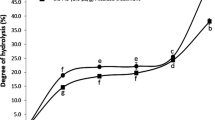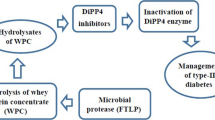Abstract
α-Lactalbumin (ALA) and β-lactoglobulin (BLG) are the main proteins in acid whey and proteolytic digestion of these proteins provides a source of peptides that inhibit angiotensin-I converting enzyme (ACE-I). Enzymatic hydrolysis of acid whey proteins using cysteine peptidase enzyme extract (antiacanthain) from ripe Bromelia antiacantha Bertol fruit was investigated. The effect of pH on hydrolysis kinetics of ALA and BLG by antiacanthain was analysed at 50 °C. Antiacanthain had a high catalytic efficiency for ALA (1.3 × 104 M−1 s−1) and BLG (1.7 × 104 M−1 s−1) at pH 9.2. The effect of temperature and amount of antiancanthain (enzyme to substrate ratio or E/S) on acid whey hydrolysis were studied by measurement of degree of hydrolysis (DH) and protein degradation profile evaluated by tricine–sodium dodecyl sulfate-polyacrylamide gel electrophoresis (tricine–SDS-PAGE). Optimal acid whey hydrolysis was at pH 9.2, E/S = 1.0 (U/mg) and 50 °C. BLG was degraded faster than that of ALA, but after 30 min hydrolysis almost all BLG and ALA were degraded and new bands corresponding to peptides with a mass lower than 3.0 kDa appeared. Fractions of acid whey (DH = 12.3%), ALA (DH = 17.3%) and BLG (DH = 30.6%) hydrolyzates showed ACE-I inhibitory activity. Results also suggest that most inhibitory activity might be due to low molecular weight peptides from ALA, since 3 kDa permeate of ALA hydrolyzate showed the highest IC50 value (1.7 ± 0.4 µg/mL). Interestingly, low molecular weight peptides from both ALA and BLG had low immunoreactivity levels, monitored by latex agglutination tests, suggesting that these peptides could be safe for use by those with strong allergic responses. Results indicate that antiacanthain can be used as an enzymatic preparation for acid whey hydrolysis. The potential use of this hydrolyzate for manufacture of health-promoting products of high added value is discussed.




Similar content being viewed by others
References
Abubakar A, Saito T, Kitazawa H, Kawai Y, Itoh T (1998) Structural analysis of new antihypertensive peptides derived from cheese whey protein by proteinase K digestion. J Dairy Sci 81:3131–3138. https://doi.org/10.3168/jds.S0022-0302(98)75878-3
Baldasso C, Barros TC, Tessaro IC (2011) Concentration and purification of whey proteins by ultrafiltration. Desalination 278:381–386. https://doi.org/10.1016/j.desal.2011.05.055
Barros RM, Malcata FX (2002) Modeling the kinetics of whey protein hydrolysis brought about by enzymes from Cynara cardunculus. J Agri Food Chem 50:4347–4356. https://doi.org/10.1021/jf0200319
Bertucci JI, Liggieri CS, Colombo ML, Vairo Cavalli SE, Bruno MA (2015) Application of peptidases from Maclura pomifera fruit for the production of active biopeptides from whey protein. LWT Food Sci Technol 64:157–163. https://doi.org/10.1016/j.lwt.2015.05.041
Boye JI, Alli I, Ismail AA (1997) Use of differential scanning calorimetry and infrared spectroscopy in the study of thermal and structural stability of α-lactalbumin. J Agric Food Chem 45:1116–1125. https://doi.org/10.1021/jf960360z
Bradford MM (1976) A rapid and sensitive method for the quantitation of microgram quantities of protein utilizing the principle of protein-dye binding. Anal Biochem 72:248–254. https://doi.org/10.1016/0003-2697(76)90527-3
Bruno MA, Lazza CM, Errasti ME, López LMI, Caffini NO, Pardo MF (2010) Milk clotting and proteolytic activity of an enzyme preparation from Bromelia hieronymi fruits. LWT Food Sci Technol 43:695–701. https://doi.org/10.1016/j.lwt.2009.12.003
Cheison SC, Kulozik U (2017) Impact of the environmental conditions and substrate pre-treatment on whey protein hydrolysis: a review. Crit Rev Food Sci Nutr 57:418–453. https://doi.org/10.1080/10408398.2014.959115
Church FC, Swaisgood HE, Porter DH, Catignani GL (1983) Spectrophotometric Assay Using o- Phthaldialdehyde for Determination of Proteolysis in Milk and Isolated Milk Proteins. J Dairy Sci 66:1219–1227. https://doi.org/10.3168/jds.S0022-0302(83)81926-2
Cimino CV, Colombo ML, Liggieri CS, Bruno MA, Vairo-Cavalli SE (2015) Partial molecular characterization of Arctium minus aspartyl endopeptidase and preparation of bioactive peptides by whey protein hydrolysis. J Med Food 18:856–864. https://doi.org/10.1089/jmf.2014.0101
Cushman DW, Cheung HS (1971) Spectophotometric assay and properties of the angiotensin I-converting enzyme of rabbit lung. Biochem Pharmacol 20:1637–1648. https://doi.org/10.1016/0006-2952(71)90292-9
Dupont D, Croguennec T, Brodkorb A, Kouaouci R (2013) Quantitation of proteins in milk and milk products. Advanced dairy chemistry. Springer, Boston, pp 87–134. https://doi.org/10.1007/978-1-4614-4714-6_3
Dziuba M, Darewicz M (2007) Food proteins as precursors of bioactive peptides—classification into families. Food Sci Technol Int 13:393–404. https://doi.org/10.1177/1082013208085933
Fitzgerald RJ, Murray BA (2006) Bioactive peptides and lactic fermentations. Int J Dairy Technol 59:118–125. https://doi.org/10.1111/j.1471-0307.2006.00250.x
Fox PF, Guinee TP, Cogan TM, McSweeney PLH (2017) Whey and whey products. Fundamentals of cheese science. Springer, Boston, pp 755–769. https://doi.org/10.1007/978-1-4899-7681-9_22
Fullana N, Braña V, José Marizcurrena J, Morales D, Betton J-M, Marín M, Castro-Sowinski S (2017) Identification, recombinant production and partial biochemical characterization of an extracellular cold-active serine-metalloprotease from an Antarctic Pseudomonas isolate. AIMS Bioeng 4:386–401. https://doi.org/10.3934/bioeng.2017.3.386
Ganju S, Gogate PR (2017) A review on approaches for efficient recovery of whey proteins from dairy industry effluents. J Food Eng. https://doi.org/10.1016/j.jfoodeng.2017.07.021
Gonzalez-Tello P, Camacho F, Jurado E, Paez MP, Guadix EM (1994) Enzymatic hydrolysis of whey proteins: I. Kinetic models. Biotechnol Bioeng 44:523–528. https://doi.org/10.1002/bit.260440415
Haug IJ, Skar HM, Vegarud GE, Langsrud T, Draget KI (2009) Electrostatic effects on β-lactoglobulin transitions during heat denaturation as studied by differential scanning calorimetry. Food Hydrocoll 23:2287–2293. https://doi.org/10.1016/j.foodhyd.2009.06.006
Hernández-Ledesma B, Ramos M, Recio I, Amigo L (2006) Effect of β-lactoglobulin hydrolysis with thermolysin under denaturing temperatures on the release of bioactive peptides. J Chromatogr A 1116:31–37. https://doi.org/10.1016/j.chroma.2006.03.006
Hong F, Ming L, Yi S, Zhanxia L, Yongquan W, Chi L (2008) The antihypertensive effect of peptides: a novel alternative to drugs? Peptides. https://doi.org/10.1016/j.peptides.2008.02.005
Jäkälä P, Vapaatalo H (2010) Antihypertensive peptides from milk proteins. Pharmaceuticals. https://doi.org/10.3390/ph3010251
Lieske B, Konrad G (1996) Interrelation between pH and availability of α-lactalbumin and β- lactoglobulin for proteolysis by papain. Int Dairy J 6:359–370. https://doi.org/10.1016/0958-6946(95)00028-3
Macció L, Vallés D, Cantera AMB (2013) Proteolytic enzymes from Bromelia antiacantha as tools for controlled tissue hydrolysis in entomology. Springerplus 2:1–7. https://doi.org/10.1186/2193-1801-2-307
Mullally MM, Meisel H, Fitzgerald RJ (1997) Identification of a novel angiotensin-I-converting enzyme inhibitory peptides corresponding to a tryptic fragment of bovine β-lactoglobulin. FEBS Lett 402:99–101. https://doi.org/10.1016/S0014-5793(96)01503-7
O’Mahony JA, Fox PF (2013) Milk proteins: introduction and historical aspects. Advanced dairy chemistry. Springer, Boston, pp 43–85. https://doi.org/10.1007/978-1-4614-4714-6_2
Otte J, Shalaby SM, Zakora M, Pripp AH, El-Shabrawy SA (2007) Angiotensin-converting enzyme inhibitory activity of milk protein hydrolysates: effect of substrate, enzyme and time of hydrolysis. Int Dairy J 17:488–503. https://doi.org/10.1016/J.IDAIRYJ.2006.05.011
Peñas E, Restani P, Ballabio C, Préstamo G, Fiocchi A, Gomez R (2006) Evaluation of the residual antigenicity of dairy whey hydrolysates obtained by combination of enzymatic hydrolysis and high-pressure treatment. J Food Prot 69:1707–1712
Polgár LAA (2013) Catalytic mechanisms of cysteine peptidases. Handbook of proteolytic enzymes. https://doi.org/10.1016/B978-0-12-382219-2.00405-1
Ryan MP, Walsh G (2016) The biotechnological potential of whey. Rev Environ Sci Biotechnol. https://doi.org/10.1007/s11157-016-9402-1
Schägger H (2006) Tricine–SDS-PAGE. Nat Protoc 1:16–22. https://doi.org/10.1038/nprot.2006.4
Schneider CA, Rasband WS, Eliceiri KW (2012) NIH Image to ImageJ: 25 years of image analysis. Nat Methods 9:671–675. https://doi.org/10.1038/nmeth.2089
Silvestre MPC, Silva MR, Silva VDM, de Souza MWS, de Junior L, de Oliveira C, Afonso WD (2012) Analysis of whey protein hydrolysates: peptide profile and ACE inhibitory activity. Braz J Pharm Sci 48:747–757. https://doi.org/10.1590/S1984-82502012000400019
Tavares GT, Malcata FX (2013) Whey proteins as source of bioactive peptides against hypertension. In: Hernández-Ledesma B, Chia-Chien H (eds) Bioactive food peptides in health and disease. InTech Open, Rijeka, pp 75–114. https://doi.org/10.5772/52680
Tavares T, Contreras MDM, Amorim M, Pintado M, Recio I, Malcata FX (2011) Novel whey-derived peptides with inhibitory effect against angiotensin-converting enzyme: in vitro effect and stability to gastrointestinal enzymes. Peptides 32:1013–1019. https://doi.org/10.1016/j.peptides.2011.02.005
Vallés D, Cantera AMB (2018) Antiacanthain A: new proteases isolated from Bromelia antiacantha Bertol. (Bromeliaceae). Int J Biol Macromol 113:916–923. https://doi.org/10.1016/j.ijbiomac.2018.03.025
Vallés D, Furtado S, Cantera AMB (2007) Characterization of news proteolytic enzymes from ripe fruits of Bromelia antiacantha Bertol. (Bromeliaceae). Enzyme Microb Technol 40:409–413. https://doi.org/10.1016/j.enzmictec.2006.07.011
Villadóniga C, Battistoni J, Cantera AMB (2007) Monitoring immunoreactivity reduction of whey proteins hydrolysates by latex agglutination. Enzyme Microb Technol. https://doi.org/10.1016/j.enzmictec.2006.07.025
Yoshikawa M (2015) Bioactive peptides derived from natural proteins with respect to diversity of their receptors and physiological effects. Peptides 72:208–225. https://doi.org/10.1016/j.peptides.2015.07.013
Acknowledgements
This work was supported by a Grant from DINACYT (PDT 74/10), CSIC (UdelaR) (Grant no. C278-348). C. Villadóniga (partially) and L. Macció were supported by PDT 74/10. C. Villadóniga received a doctoral fellowship from ANII (Grant no. POS_NAC_2010_1_2_2438).
Author information
Authors and Affiliations
Corresponding author
Rights and permissions
About this article
Cite this article
Villadóniga, C., Macció, L. & Cantera, A.M.B. Acid whey proteolysis to produce angiotensin-I converting enzyme inhibitory hydrolyzate. Environmental Sustainability 1, 267–278 (2018). https://doi.org/10.1007/s42398-018-0027-x
Received:
Revised:
Accepted:
Published:
Issue Date:
DOI: https://doi.org/10.1007/s42398-018-0027-x




